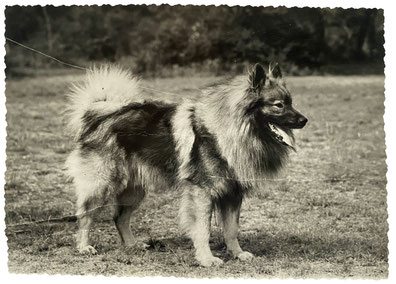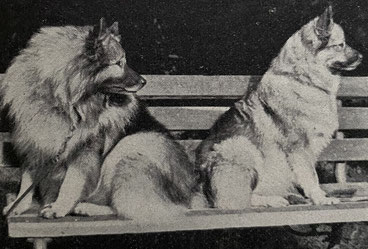The Wolfspitz and his coat
A worrying development
Lush, well off-standing hair in the Wolfspitz has always been the pride of its owner, because an animal with magnificent fur in good condition is certainly an eye-catcher. However, our Wolfspitz's fur has undergone quite a change in the last few decades: it is becoming fuller and longer. (And more colorless.) The dogs that were bred earlier not only had shorter hair, but also thicker and harsher hair, and therefore appeared much slimmer and leggier than they currently do - as can be clearly seen in old photos.
The two pictures on the left show the old, hard Wolfspitz fur, the pictures on the right show the more plush fur of "modern" Wolfspitz/Keeshond
The overly pompous coat - as beautiful as it can be when well cared for - sometimes gives the impression that the dog is suffering under the weight of that fur, that its mobility is restricted and that it must be a hell of a job to keep this fur in good shape. For example, if my Kuno - who's coat is very, very moderately for today's Wolfspitz trend - had previously lived on a farm, I think that he would have looked like a big felt lump. What does it look like for the Keeshond types? And can the average Spitz owner even cope with the complex, time-consuming care required to ensure that the fur doesn't become matted?

Actually, the Wolfspitz fur should be made in such a way that when the dog gets wet and then shakes himself, it looks as if the fur is completely dry. Then, and only then, does the hair have the right off-standing undercoat and is hard enough.
It would also be better for our Wolfsspitz if the judges at dog shows could be a little more careful with the statement "The dog is not yet full of hair"! Not all dogs necessarily have long, soft fur; maybe the shorter one is much more functional. It is up to the judge to decide whether mountains of fur alone give preference to one dog when awarding, or whether the resulting masses of fur become more harmful than beneficial to the Wolfspitz as a living creature. In addition, the cultivated fur masses also very effectively conceal defects in the building. Maybe you should hold a dog show in heavy rain so that, as if by magic, smaller defects can be seen that would not be noticed by the judges if the coat was dry and hairdressed?!

Unfortunately, this type of plush increasingly corresponds to the prevailing ideal of beauty and our current interpretation of the FCI standard. The judges prefer such animals to other dogs at shows, the breeders select the award-winning winning dogs in order to use them for breeding, and everything boils down to the fact that the Keeshond type continues to stabilize in the appearance of the Wolfsspitzes. The question is what effects these changes have on the exterior of the Wolfsspitzes:
Are illnesses becoming more common?
What about the quantity of puppies of dogs with these mountains of fur?
Has average life expectancy decreased and if so, by how much?
Do our Wolfsspitzes still correspond to their actual, functional nature, or is it becoming more and more atypical?
How do the dogs actually fare under these masses of fur?

These are all questions that the judges cannot assess during the few minutes in which they see the dog in question in the ring. You can only devalue animals in which the health deficiencies are very obvious. Mmm. 🤔
Thematically relevant, some food for thought from a long-time Wolfsspitz breeder: Changing the type of Wolfsspitz
At this point I would like to quote Heinrich Sassenberg (board member of the German Spitz Club from 1931 to 1964), who once wrote:"Our Spitzes must never fall victim to the fashion craze in terms of breeding goals, because this usually means that their nature and character are lost." Our German Wolfsspitz should, first and foremost, be a guardian, and the nature of its coat makes it suitable for spending time outdoors all year round. So let's go back to the roots - to what was and is natural, practical and logical at Spitz. And that was and is the functional, not too lush and firm fur!
A few more words about caring for the Wolfsspitz's fur

A well-kept and well-bred Wolfspitz needs no more grooming than any other dog breed. However, you still have to take care of him and ensure that his coat is in good condition; This effort is rewarded with a magnificent coat of hair. However, this goes through a few changes before it is completed:
Newborn puppiess, who are born with smooth, close-fitting fur, gradually stand up their hair over the course of the first few weeks. At eight or nine weeks, the first guard hairs grow through and the ruff gradually forms. Tail hair, pants and feathers also form. At two to three months, the entire Wolfsspitz is finally a single fluffy ball of yarn.
But then comes the setback - the first coat change begins. In the sixth to seventh month, the youngster is certainly not a beauty. Brushing is particularly useful during this time, but always against (!) the direction of growth. The German Spitz generally does not show its final coat until between the second and third year of life.

Regarding the undercoat: There are two opinions existing. Firstly, that the undercoat should be completely removed (better not, otherwise the hair will just hang flat) and secondly, that the undercoat should not be allowed to come out. This is just as wrong, because as soon as it comes off, it has to be groomed out, because the easier it is for the new hair to grow. If the undercoat is not removed at all, the end result is completely matted fur that smells bad, can cause skin diseases and is a burden for the dog itself.
You should hardly ever bathe the Wolfspitz, as bathing too often damages the animal's hair and skin. Before a show it is absolutely sufficient to wash the tail, feathers and trousers to achieve the right shine - nothing more. It is better not to use a wire brush for brushing, but rather a classic brush with long teeth. It is best to comb out matted areas with a comb before finally wiping the fur with a damp chamois leather.
To maintain the beauty of the ruff, simply let the Wolfsspitz walk without a collar as often as possible. Round leather collars have proven to be suitable as they are gentle on the fur.
Detailed instructions on how to care for the Spitz's coat can also be found in my article "Caring and grooming a German Spitz".
20.07.23








